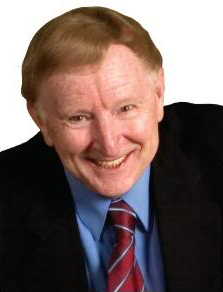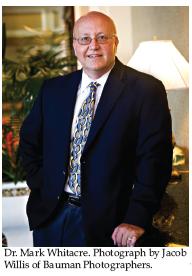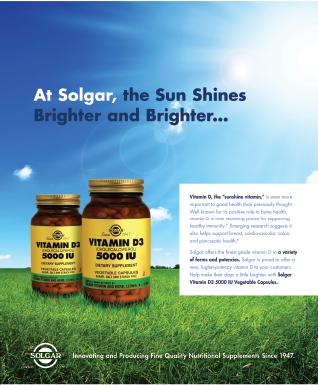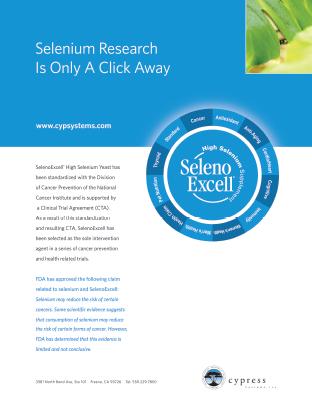Enough is enough! There was an onslaught of misinformation generated by the media when the National Cancer Institute’s (NCI) Selenium and Vitamin E Cancer Prevention Trial (SELECT), a study of the role of selenium in prostate cancer, was halted in October 2008. The media incorrectly reported the termination of the study as evidence that selenium does not reduce the risk of cancer. The fact is that a large body of scientific evidence shows that several selenium-containing nutrients do reduce the risk of many types of cancers.
Enough is enough! There was an onslaught of misinformation generated by the media when the National Cancer Institute’s (NCI) Selenium and Vitamin E Cancer Prevention Trial (SELECT), a study of the role of selenium in prostate cancer, was halted in October 2008. The media incorrectly reported the termination of the study as evidence that selenium does not reduce the risk of cancer. The fact is that a large body of scientific evidence shows that several selenium-containing nutrients do reduce the risk of many types of cancers.
Unfortunately, the way many scientists disseminate information is through a series of non–peer-reviewed press releases or oral symposia reports well in advance of publishing peer-reviewed journal articles. A non–peer-reviewed press release is distributed at the symposium and then again just a day before the article appears in the journal. This leads to two separate media stories about the same study in which the media has no input from qualified scientists as the scientists do not have access to the actual data, but only to the press releases.
Now, finally, the information about the SELECT study has been published and available for examination. In October 2008, I responded to the first press release generated when the SELECT study was stopped. This month, I have asked selenium researcher Dr. Mark Whitacre to respond to the published article. You will find that the ending of the SELECT study in no way contradicts the vast body of science showing that several selenium-containing nutrients reduce the risk of cancer and that the support for the cancer-preventing action of several selenium-containing nutrients is very strong indeed. And, numerous NCI-funded trials are still ongoing.
Dr. Whitacre earned a Ph.D. in nutritional biochemistry from Cornell University and holds Bachelor’s and Master’s degrees from Ohio State University (OSU). His doctoral thesis research was on the biochemical role of selenium at the cellular level. Dr. Whitacre also holds two law degrees (J.D. and LL.M). He is currently the COO and the president of operations of Cypress Systems, Inc., a Fresno, CA-based nutritional biotechnology company.
 Dr. Whitacre may be best known publicly for his role outside of biochemical research. He is recognized in the biotechnology industry as a seasoned executive with almost two decades of top management experience. Most of this experience was obtained at Fortune 500 companies prior to leading entrepreneurial companies. Much of Dr. Whitacre’s career has been in the area of biotechnology and microbial fermentation. His experience is global in scope having lived several years in Europe for an international company. He also was involved in the Southeast Asian market for two large international companies.
Dr. Whitacre may be best known publicly for his role outside of biochemical research. He is recognized in the biotechnology industry as a seasoned executive with almost two decades of top management experience. Most of this experience was obtained at Fortune 500 companies prior to leading entrepreneurial companies. Much of Dr. Whitacre’s career has been in the area of biotechnology and microbial fermentation. His experience is global in scope having lived several years in Europe for an international company. He also was involved in the Southeast Asian market for two large international companies.
As an interesting footnote, a Discovery Channel documentary entitled, Undercover, aired last month (March 2009) in which the network interviewed Dr. Whitacre and the three FBI agents who strongly support him. The FBI agents recently went public to the media and called Dr. Whitacre a national hero. Also, a thrilling Matt Damon movie has been made on the aspects of Dr. Whitacre’s life dealing with bravery and doing “the right thing.” We will explore some of the aspects of the movie in another interview just before it is released to the theaters in September… but we won’t destroy the suspense!
See www.markwhitacre.com for more details on the biography of Mark Whitacre.
Passwater: Dr. Whitacre, why did you choose to study nutritional biochemistry?
Whitacre: I chose nutritional biochemistry because I was very interested in the field of science in college. I enjoy exploring how things work at the cellular level.
Passwater: What led you to research selenium?
Whitacre: While at OSU in the late 1970s, I kept reading scientific journal articles about how this new nutrient, selenium, showed tremendous potential at the cellular level. I noted that much of the research was coming out of Cornell University at the time. So, I finished my B.S. and M.S. at OSU and went to Cornell to work on my Ph.D. under Dr. G.F. Combs, Jr., the scientist who was doing much of the selenium research.
 Passwater: Of course, I knew you studied under Dr. Jerry Combs, Jr. In my early research with selenium, I corresponded with Dr. Milton Scott of Cornell University. Dr. Combs joined Dr. Scott in 1972 or so, and I have had the pleasure of communicating with both of them during some very exciting years of selenium research.
Passwater: Of course, I knew you studied under Dr. Jerry Combs, Jr. In my early research with selenium, I corresponded with Dr. Milton Scott of Cornell University. Dr. Combs joined Dr. Scott in 1972 or so, and I have had the pleasure of communicating with both of them during some very exciting years of selenium research.
Selenium researchers have made up a small community until recently. In the 1950s, there were only a handful of such researchers and the dissemination of selenium research was a slow process usually involving animal nutrition research and subjects such as mulberry heart disease in pigs, nutritional muscular dystrophy, white muscle disease in cattle, “stiff lamb” disease, exudative diathesis in chickens and an elusive “factor-3,” which is what caught my attention. My 1980 book, Selenium As Food and Medicine (Keats Publ.), was posthumously dedicated to Dr. Klaus Schwarz, who did his research at the National Institutes of Health on factor-3. Dr. Julian Spallholz of Texas Tech University wrote the introduction. As I mentioned in the book’s first chapter, the other selenium researchers with whom I was collaborating at the time included Drs. Milton Scott and Jerry Combs at Cornell, Dr. Al Tappel at University of California at Davis, Dr. Doug Frost at Dartmouth Medical School, Dr. Raymond Shamberger of the Cleveland Clinic Foundation and Dr. Gerhard Schrauzer at University of California at San Diego. We will be once again chatting with Dr. Schrauzer soon.
What was the subject of your doctoral thesis in selenium research?
Whitacre: My Ph.D. research involved studying the biochemical role of selenium in the pancreas. In the early 1980s, my research at Cornell further studied the important “antioxidant” properties of selenium at the cellular level as an integral part of the enzyme, glutathione peroxidase.
Passwater: Dr. Combs was a key researcher collaborating with Dr. Larry Clark in the Nutrition Prevention Study that was published in 1996 showing that selenium yeast cut cancer risk and death by 50%. Was Dr. Combs preparing for or working on the Nutritional Prevention of Cancer (NPC) study while you were with him?
Whitacre: Yes, he was preparing for the NPC trial when I was at Cornell. And the study actually started in 1983, the year I graduated from Cornell with my Ph.D. But, it was being planned well before that.
Passwater: What did the NPC study determine?
Whitacre: The gold-standard NPC clinical trial was published in the Journal of American Medical Association (JAMA) in December 1996 (1). The study found that supplementation with 200 micrograms of selenium per day from high-selenium yeast reduced lung, colon and prostate cancer incidence by 50–63%.
Passwater: There have been other studies such as SU.MAX.IX and the Chinese clinical trials that have added support to the 1996 NPC study (1), but much emphasis recently has been on the SELECT study. What was your reaction when it was announced that this trial was halted?
Whitacre: I was not too surprised, as the form of selenium used in SELECT was selenomethionine. It was not high-selenium yeast and there are differences between the two selenium forms. The lack of effect of selenomethionine for cancer prevention in the SELECT study is consistent with the previous animal data. For example, Dr. McCormick at the Experimental Toxicology and Carcinogenesis Division, IIT Research Institute in
Chicago found no effects with selenomethionine supplementation on the prevention of prostate cancer in rats (2).
Furthermore, research at Purdue University found high-selenium yeast to be more effective than selenomethionine in reducing DNA damage in canine prostate cells (3).
Passwater: Selenomethionine is a selenium-containing nutrient that provides selenium nourishment and has been shown to have some anti-cancer properties. However, there are several reasons why selenomethionine is not the compound of choice for cancer prevention, especially prostate cancer prevention. Selenomethionine is the only selenium-containing nutrient that is diverted from cancer prevention by unrelated pathways.
In fact, Dr. Combs and colleagues have shown that Se-methylselenocysteine (also simply called methylselenocysteine) was superior to selenomethionine against prostate cancer cells in a dose-dependent inhibition response (4). Selenomethionine at the same dosage was not cancer growth inhibitory in this study. Selenomethionine accumulated four times higher in the liver than methylselenocysteine is one of the methylselenol precursors found in some selenium yeasts and is also available as a dietary supplement.
Did the SELECT study call into question earlier clinical trials that have been published in scientific journals?
Whitacre: The SELECT study found no cancer risk reduction activity of one chemical form of selenium, namely selenomethionine used at a single dose. While the study did not add support to the earlier studies, we find that the SELECT study does not call into question earlier clinical trials that have been published in scientific journals. More importantly, the SELECT study does not shift the overwhelming scientific support that selenium has an important role in cancer risk reduction. A very extensive body of animal and cell culture data further provide strong evidence to support the human clinical results in which high-selenium yeast has been shown to be effective in reducing the risk of certain types of cancer. In addition, the lack of effect of selenomethionine for cancer prevention in the SELECT study is consistent with the previous animal data.
Passwater: We objected to not using selenium yeast all along because selenium yeast was already shown to be greatly and dramatically effective against cancer in the NPC study. Note that Dr. Combs and colleagues discuss this point in the study I just mentioned. “On the key issue of the selection of the forms of selenium for such trials, the research did not follow the usual drug/agent development paradigm of identifying the active compounds in test tube- and cell culture-based studies, establishing their efficacy in preclinical animal models and then progressing to human clinical trials… the arguments can be assured to continue into the future for additional human trials.” (4). What are your thoughts?
 Whitacre: One of the SELECT study’s authors, Dr. Alan R. Kristal, stated in a recent editorial that the possibility remains that the decisions of SELECT regarding dose and formulation were wrong (5).
Whitacre: One of the SELECT study’s authors, Dr. Alan R. Kristal, stated in a recent editorial that the possibility remains that the decisions of SELECT regarding dose and formulation were wrong (5).
Passwater: Did they not understand that while selenomethionine is okay for basic selenium nourishment, most of it can unintentionally go directly into non–cancer-related proteins as the body mistakes it for methionine during methionine deficiency? Did the SELECT researchers test to see if their subjects were adequately nourished with methionine or did they measure the selenium compounds formed in the blood?
Whitacre: The SELECT authors, Lippman et al., stated that “Potential limitations of SELECT include that it did not test different formulations or doses of selenium and vitamin E and that it did not definitively assess results in subgroups of men who may have responded differently than did the overall population” (6).
Passwater: Selenomethionine does have an anti-cancer effect against some cancers under certain conditions, but it is not an especially potent anti-cancer nutrient even then and, under some conditions, it has little, if any, effect. Aside from the fact that selenomethionine is the only nutrient form of selenium that can be diverted from the anti-cancer pathways, what is it about selenium yeast as a nutrient that makes it the nutrient of choice to be tested by NCI as in the NPC Study?
Whitacre: At the recent American Institute of Cancer Research conference, the SELECT results were thoroughly discussed and Dr. Karam El-Bayoumy of the Penn State Hershey Cancer Institute called the case against selenium far from closed (7). His research, which used high-selenium yeast instead of selenomethionine, has shown a benefit for selenium for cancer risk reduction. Moreover, Dr. El-Bayoumy found the mechanisms of prevention to be far-reaching: “Collectively, based on mechanistic studies conducted in our laboratory and others in preclinical systems, it appears that selenium can alter cellular and molecular targets implicated in prostate cancer progression, recurrence, and metastasis, and thus, selenium compounds have the potential to promote prostate cancer survivorship” (6). He further stated, “Selenium compounds should be considered for further exploration as primary or supplemental treatment options for advanced prostate cancer in addition to their role as chemopreventive agents.” Furthermore, in the same publication, Dr. John A. Milner, chief of NCI’s Nutritional Science Research Group, stated that dietary supplements can differ in quality and vary from brand to brand (7).
Passwater: Was there anything else in the SELECT Trial that was a problem?
Whitacre: It remains very likely that persons not optimally nourished with selenium will benefit from selenium supplementation, namely, those with baseline plasma selenium levels below 120 ng/ml. The SELECT results showed that both the placebo and treatment groups to be above the 120 ng/ml level, where no further selenium supplementation was found to be effective. On the contrary, selenium supplementation was found to be effective in the sub-group with baseline plasma selenium levels below 120 ng/ml in the NPC trial.
It is well documented in the University of Arizona and Cornell University gold-standard clinical trial that high-selenium yeast supplementation (at 200 micrograms per day) reduced the incidence of lung, colon and prostate cancers by as much as 63% (1). Researchers at the Penn State Hershey Cancer Institute found that supplementation with high-selenium yeast reduced oxidative stress and serum PSA levels, risk factors for prostate cancer in humans (8). In the SELECT study, it appears that selenomethionine had no effect on PSA levels (6). We emphasize that both the Clark clinical chemoprevention study (1) and the El-Bayoumy pilot clinical study (8) used high-selenium yeast and not selenomethionine.
Passwater: The European Prospective Investigation into Cancer and Nutrition Study (EPIC) was also criticized for trying to find a nutritive effect in persons already in the well-nourished range. Drs. Fairweather-Tait and Hurst have just commented in the American Journal of Clinical Nutrition in respect to the EPIC Study. “At a serum selenium concentration of 90 µg/L, the hazard ratio for mortality from prostate cancer is 2.0 (twice the normal risk), and only when serum selenium reaches 105 µg/L does the risk fall to 1.0 (normal) . . . minimum risk is at 135 µg/L” (9).
We cannot expect to see a reduction in cancer risk unless the subjects have less than optimal blood levels of selenium to begin with and they are given a dosage sufficient to raise blood levels to or near the optimal level.
Getting back to selenium form, what could be the possible biochemical differences between selenomethionine and high-selenium yeast at the cellular level?
Whitacre: We and many other selenium experts believe that the SELECT study should have included the standardized high-selenium yeast, which has been found effective in reducing cancer risk in animal studies and human clinical trials. High-selenium yeast is different from the single synthetic amino acid compound, selenomethionine, used in the SELECT study. High-selenium yeast contains several different natural anabolic and catabolic forms of organically bound selenium in addition to selenomethionine such as selenocysteine, methylselenocysteine and several other selenium compounds, all organically bound. We suspect that the advantage of high-selenium yeast lies in its content of multiple forms of selenium, including some forms that are more effective than selenomethionine in anti-carcinogenesis.
More importantly, current research at Penn State Hershey Cancer Research Institute is aimed at comparing high-selenium yeast and selenomethionine on biomarkers of prostate cancer risk. This research was recently funded by the NCI. In addition, there are numerous other ongoing human clinical selenium trials listed at the ClincalTrials.gov Web site at http://clinicaltrials.gov/ct2/results?term=selenium. Many of these trials are funded by the NCI and have the sole purpose of studying the effectiveness of selenium on cancer prevention. Further research is currently ongoing to provide additional support that the form of selenium is of paramount importance in its effectiveness for cancer risk reduction.
The underlying mechanisms for selenium and anti-carcinogenesis were identified in a recent publication (10). Besides the chemical form of selenium being a potential factor in selenium’s effectiveness for cancer prevention, another scientific possibility that may account for the lack of effect of selenomethionine in SELECT study is that free-SeMet is not being used like protein-bound selenomethionine in high-selenium yeast. For example, free-selenomethionine may be more susceptible to oxidation (which then converts to selenomethionine selenoxide) than it is within a protein. This may be caused by some sort of protection due to the tertiary folding of the protein itself. We know that selenomethionine is more sensitive to oxidation than its S-analogue and, as a result of its oxidation, it would reduce its bioavailability.
Passwater: So, to sum up, is your evaluation of SELECT as an experienced selenium researcher that the predominance of scientific evidence indicates that selenium is involved in reducing the risk of many cancers?
Whitacre: Yes! In fact, I believe the SELECT results add clarity to the form and dose of selenium as critical determinants in cancer risk reduction. Clarity, by confirming that subjects with relatively high baseline levels of selenium will not benefit from supplementation. This is exactly what was found in the NPC trial of Drs. Clark and Combs (1) and is what Dr. Walter Willet suggested over 25 years ago from his cohort study (11). It remains very likely that a significant sub-group of subjects will benefit from selenium supplementation, namely, those with baseline plasma selenium levels below 120 ng/ml. The SELECT results showed that both the placebo and treatment groups were above the 120 ng/ml level, where no further selenium supplementation was found to be effective. In the NPC trial, however, selenium supplementation was found to be effective in the sub-group with baseline plasma selenium levels below 120 ng/ml.
Much research has been conducted (and more still underway) that provides additional support that the form of selenium is also of paramount importance in its effectiveness for cancer risk reduction. As mentioned previously, we suspect that the advantage of high-selenium yeast lies in its content of multiple forms of selenium, including some forms that are more effective than selenomethionine in anti-carcinogenesis.
Passwater: With selenium form being so important, are all high-selenium yeasts the same?
Whitacre: No, they are not. As a matter of fact, Cypress’ flagship branded ingredient, SelenoExcell High Selenium Yeast, was the product used in the original NPC trial published in JAMA in 1996 (1). Following this publication, SelenoExcell was standardized and approved as the research standard selenium yeast source by the Division of Cancer Prevention of the National Cancer Institute, which led to the signing of a Clinical Trial Agreement in 1998. As a result of these efforts, SelenoExcell has been selected as the sole intervention agent in a series of cancer prevention and health-related trials that are currently being conducted by the NCI.
Passwater: Thank you for examining the recent SELECT study published results with us. I am sure our readers will be watching for the Discovery Channel documentary, Undercover, and the Matt Damon movie and our discussion this fall. WF
Note: As we were going to press, two selenium articles related to this discussion appeared in the scientific literature. A study from the University of North Carolina published in Nutrition and Cancer showed that individuals who had both high blood (serum) selenium levels (>140 mcg/l) and high reported folate intakes (>354 mcg/day) cut their risk for colon cancer in half (12). A study from the MD Anderson Cancer Center published in the Journal of the National Cancer Institute determined that selenium and vitamin E supplementation favorably changed the genetic expression in prostate cancer cells, indicting a protective action (13).
References
1. L.C. Clark et al., “Effects of Selenium Supplementation for Cancer Prevention in Patients with Carcinoma of the Skin: A Randomized Controlled Trial. Nutritional Prevention of Cancer Study Group,” JAMA 276 (24), 1957–1963 (1996).
2. D.L. McCormick and K.V. Rao, “Chemoprevention of Hormone-Dependent Prostate Cancer in the Wistar-Unilever Rat,” Eur. Urol. 35 (5–6), 464–467 (1999).
3. D.J. Waters, “Effects of Dietary Selenium Supplementation on DNA Damage and Apoptosis in Canine Prostate,” J. Natl. Cancer Inst. 95 (3), 237–241 (2003).
5. A.R. Kristal, “Are Clinical Trials the ‘Gold Standard’ for Cancer Prevention Research?” Cancer Epidemiol. Biomarkers Prev. 17 (12), 3289–3291 (2008).
6. S.M. Lippman et al., “Effect of Selenium and Vitamin E on Risk of Prostate Cancer and other Cancers: The Selenium and Vitamin E Cancer Prevention Trial (SELECT),” JAMA 301 (1), 39–51 (2009). Epub 2008 Dec 9.
7. P. Eastman, “AICR Conference: Warning about Dietary Supplements for Cancer Patients; Provocative Mechanistic Data on Selenium & Folate; New Insights into Vitamin D & Cancer,” Oncology Times, 31 (1), 12–13 (2009).
8. K. El-Bayoumy et al., “Influence of Selenium-Enriched Yeast Supplementation on Biomarkers of Oxidative Damage and Hormone Status in Healthy Adult Males: A Clinical Pilot Study,” Cancer Epidemiol. Biomarkers Prev. 11 (11), 1459–1465 (2002).
9. S. Fairweather-Tait and R. Hurst, “Plasma Selenium Concentration and Prostate Cancer Risk: Effects are Dependent on the Level of Exposure,” Am. J. Clin. Nutr. 89, 927–928 (2009).
10. M.I. Jackson and G.F. Combs, Jr., “Selenium and Anticarcinogenesis: Underlying Mechanisms,” Curr. Opin. Clin. Nutr. Metab. Care, 11 (6), 718–726 (2008).
11. W.C. Willet et al., “Prediagnostic Serum Selenium and Risk of Cancer,” Lancet, 2 (8342), 130–134 (1983).
12. A. Connelly-Frost, C. Poole, J.A. Satia, et al., “Selenium, Folate and Cancer,” Nutr. Cancer 61(2), 165–178 (2009).
13. D. Tsavachidou, et al., “Prostate Biopsy Samples Show Evidence of Differential Gene Expression in Patients After Supplement Use,” J. Natl. Cancer Inst. advance access published on February 24, 2009.
Dr. Richard Passwater is the author of more than 40 books and 500 articles on nutrition. He is the vice president of research and development for Solgar, Inc. Dr. Passwater has been WholeFoods Magazine’s science editor and author of this column since 1984. More information is available on his Web site, www.drpasswater.com
Published in WholeFoods Magazine, April 2009










